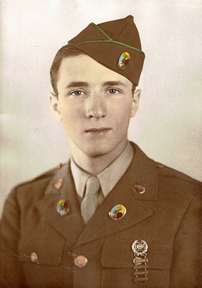 Cpl. Harry Paston
- Armored Replacement Training Center - Ft. Knox, Ky. 1944
Cpl. Harry Paston
- Armored Replacement Training Center - Ft. Knox, Ky. 1944
Click the image for a larger view |
WITH THE 7TH
INFANTRY DIVISION:
OKINAWA TO KOREA
1945-1946
by Harry Paston
|
In the summer of 1945 as the battle for Okinawa was winding down for
the 7th Infantry Division, after 89 days of combat and approximately
7,100 casualties, I was serving with the 7th Infantry Division artillery.
|
With hostilities declared ended except for pockets of scattered
Japanese resistance in caves, our thoughts were turning to the
impending invasion of the Japanese homeland. Germany had surrendered
in May, the conquest of Japan would end the war.
Training for the invasion, code-named Olympic and
|
scheduled for November
1st, was to start soon with the first phase landings on Kyushu with
up to half million troops involved. High casualties were anticipated
as the Japanese had demonstrated throughout the war in the Pacific,
their commitment to fight to the death for their emperor.
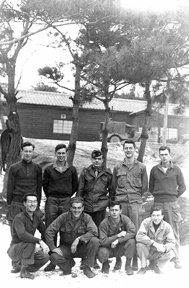
7th Signal Company
Radio Section-L-R Top Row: Brandon, Stewart, Kremers, MacKellar,
Estes
L-R-Bottom Row: White, Cowen, Welch, Paston (5 men of total
14 in a section not shown-Seoul, Korea - Jan. 1946
Click
the image for a larger view
|
The 7th Infantry Division, battled hardened
on the Alaska Aleutian islands of Attu and Kiska, on Kwajalein
and Eniwetok, Leyte in the Philippines and Okinawa, was one
of the units that would be involved.
In late August, while sitting in my
tent, I was visited by Lt. Col. Dahlstrom, the Division Chief
Signal Officer, and told to pack my gear and report to the 7th
Signal Company. While my training as a medium tank crewman qualified
in firing the 75mm canon got me assigned as an artillery forward
observer, the transfer to the Signal Company was as a result
of my being an amateur radio operator before the war. Never
found out how the Army knew that, but the 7th Signal needed
men to replace those being rotated back to the States.
However, the dropping of the atom bomb
on Hiroshima on August 6th and then Nagasaki and the surrender
of Japan on August 14th changed everything for us! The Division
was ordered to accept the Japanese surrender of Korea and occupy
the country. The formal surrender of Japan took place on September
2nd aboard the USS Missouri in Tokyo Bay and the occupation
of Japan started August 28th.
|
Russia had declared war on Japan
August 8th and one million troops invaded Japanese held Manchuria
and were proceeding towards the Korean peninsula. An agreement had
been reached that the Russians would occupy Korea, which had been
a Japanese colony since 1910, north of the 38th parallel; the U.S.
south of the parallel which would be the demarcation line that effectively
established the border between what would become North and South Korea.
While the United States encouraged a Korean self-government in the
south, the Russians established a communist government in the north.
Little did anyone imagine then how this would turn out!
The occupation of Korea by the Division was scheduled for
September 8th. Before I could get settled in the 7th Signal,
I was assigned as the radioman for a three-man team that would
land in advance of the main body, charged with a mission to
meet Japanese representatives and ensure the surrender would
occur, as arranged in Tokyo.
The Division sailed from Okinawa in a 37 ship convoy on September
5th, bound for Inchon (Japanese name was Jinsen) on the west
coast of Korea. H-hour for the main landing on September 8th
was scheduled
|
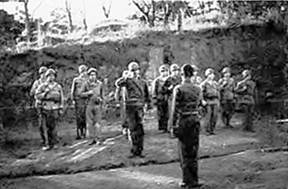
7th
Signal Company Radio Selection-Morning Roll Call — Korea
1945
Click
the image for a larger view
|
for 1500 (3 p.m.). My team
headed by Brigadier General LeRoy Stewart, the Division artillery
commander (who was to become the Provost Marshall in Korea), a military
government Japanese interpreter and myself, loaded down with a portable
radio and weapons, were landed at 4:02 a.m. the morning of September
8th. We were to await the arrival of a Japanese contingent who we
were told would meet us in the harbor area and confirm the surrender.
Needless to say, we were quite nervous not knowing if they might arrive
with guns blazing! (I carried with me top-secret maps of the Inchon
harbor area which I kept for75 years!)
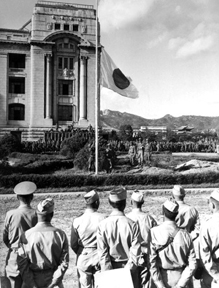 Japanese flag being
lowered in Korea (Wikipedia)
Japanese flag being
lowered in Korea (Wikipedia)
Click the image for a
larger view |
A Japanese contingent
in company strength led by a general arrived in the morning.
In a formal action, the Japanese general handed his sword
to General Stewart and confirmed the surrender ceremony for
the following day in Seoul.
I radioed the command
ship with the news and the embarkation began with the first
units ashore the 7th Recon Troop, equipped with light armored
vehicles. Their mission was to drive the 20 miles to Seoul
to make sure the road was clear and no hostile forces observed.
When they returned, they told us they were amazed to find
thousands of Korean civilians lining the road waving American
flags, apparently all homemade. They also told us the Koreans
kept on running across the road in front of their vehicles
barely missing getting hit. We later found out the Koreans
had a superstition that evil spirits were following them and
this was a way to get them killed!
|
The Koreans were friendly and
happy to see us; the Japanese soldiers were stoic and unlike our combat
experiences with them, appeared to accept the fact they had lost the
war. They, together with the majority of the 800,000 Japanese "colonists"
living in Korea, were returned to Japan in the following months.
In fact, we used Japanese trucks
driven by their soldiers initially to move units around Inchon, while
our equipment was coming ashore.
| As the Division units starting
coming ashore, I was ordered to set up a division radio net from
a position atop the Munitions Building near the harbor utilizing
a Signal Corps Radio Model 284, the workhorse of Infantry units.
I was then assigned to the 17th Infantry, where while stringing
a long wire radio antenna, a most memorable event occurred: while
walking backwards I managed to fall into a Japanese latrine dug
in the ground. Fortunately, my fellow soldiers used their helmets
full of water to clean me up! |
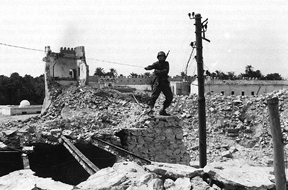
Stringing
Wire (Army History)
Click the image
for a larger view |
The 7th Division, when landed,
had the three infantry regiments active since the start of the war:
17th, 32nd, and 184th, originally a California national guard regiment,
which was shortly replaced by the 31st Regiment. With troops being
rotated home in large numbers we soon became way understrength by
1946, losing 7,500 men.
At the end of WW2, there
were 89 infantry divisions in the Army; by 1950 only ten remained,
one of which was the 7th.
The mission in Korea
was to act as a security force, assist in the establishment
of a self-governing democratic government and to patrol and
maintain outposts along the 38th parallel DMZ, a job rotated
among the three infantry regiments. Other division units were
garrisoned in different parts of South Korea from Pusan, the
southernmost city to Seoul, the capital.
Unlike the occupation
of Germany and Japan, which had been devastated by bombings,
there had been no hostilities on the Korean peninsula, so
the cities and rural areas had been untouched by war.
A week after the landing,
I rejoined the 7th Signal Company, bivouacked on the outskirts
of Seoul adjacent to government buildings. Unfortunately,
the troops were not functioning well, having liberated a Japanese
officer club liquor supply and nursing huge hangovers.
|
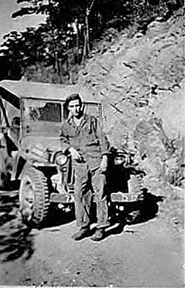
Sgt. Harry Paston — On patrol
in front of Radio Section jeep - South Korea - 1945
Click theImage for larger view
|
Eventually, Quonset Huts erected
by Army engineers replaced temporary tents, providing comfortable
barracks for living quarters. Division headquarters was established
in Seoul in government buildings formerly used by the Japanese from
which they had ruled the country as a colony, suppressing Korean culture
and requiring the Japanese language to be taught in schools and used
by the Koreans.
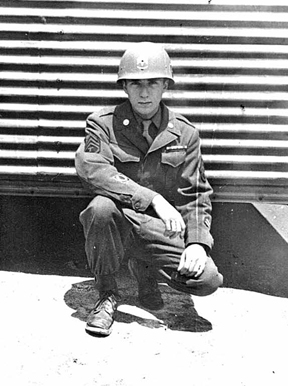
Sgt. Harry Paston - alongside Quonset hut barracks - 7th Signal
- Seoul, Korea - 1946
Click
the image for a larger view
|
Occupation duties soon became routine-and somewhat boring. Seoul
was a large city and passes allowed us to visit and explore
it but despite the friendliness of the Koreans, the language
barrier limited us to mostly sightseeing, eating and drinking.
GIs sought other unnamed recreational activities. Unlike the
Korea of today, for GIs seeking R &R away from our bases,
there was not much of interest.
Initially, following our occupation, Russian troops were stationed
in Seoul. We would meet them while in Seoul, exchange souvenirs
but the language barrier limited our interface. Unlike us, their
weapons were always loaded with live ammo and we observed many
confrontations with Korean citizens who were fair game for the
Russians threatening them and taking watches and jewelry. We
always looked the other way!
After a few months, the
small Russian contingent withdrew north of the 38th parallel.
Interaction with the locals
was minimal. We did employ Korean civilians to work at tasks
inside our garrison area such as cleaning and performing kitchen
and maintenance tasks.
|
Since I was the sergeant in charge
of the Radio Section, despite orders from Tokyo forbidding amateur
radio operations in Korea, I set up my ham radio station in an SCR-399,
a Signal Corps truck mounted radio station, which I located on blocks
on a hill adjacent to our area.
With the
end of the war, amateur radio stations came on the air again throughout
the world and I was able to communicate regularly with stations
in the States relaying messages to family members of company personnel.
I also regularly contacted a couple of stations on Tinian operated
by amateurs identified by their handles (names), Curt and Barry.
Turned out Curt was Air Force commanding General Curtis LeMay
and Barry a fellow who went on to be a U. S. Senator and presidential
candidate by the name of Barry Goldwater. Years later,
as a resident of Arizona, I renewed my friendship with him.
While the Division troops continued training exercises as a peacetime
army, we left garrison areas on patrols, testing equipment, and
tactics, throughout rural Korea, which was most of the country
at that time. On one such patrol, we stopped in a small village
on the route used by the Russian soldiers returning north. The
locals told us stories of Russian troops taking delight in breaking
glass windows in homes and shops. Glass was not a readily available
commodity so this was particularly offensive to the citizens.
|
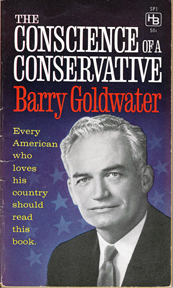
Barry Goldwaters best
seller during campaign
Click
the image for a larger view
|
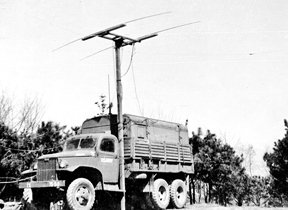
Seoul, Korea - SCR-399
radio truck - used as amateur radio station W2OAA/J8
Click the image for a larger view
|
Our unit was
called upon to supply communications to the Pauley Reparations
Commission during their visit to Korea and Manchuria. This commission
had been established by the Allied powers to obtain reparations
from Germany and other axis powers as compensation for their wartime
activities. One of the Commissions members was Colonel Gail Carter,
who was to become head of the National Electronic Distributors
Association. While an executive in the electronics industry many
years later, I was able to renew a friendship with him. |
Finally, after nearly
a year in Korea, I sailed for home on the S.S. Sea Star arriving
under the Golden Gate Bridge in San Francisco at 1:40 in the
morning of September 1st.
Following my discharge,
as a Tech Sergeant, I returned to college to earn my degree.
I was commissioned an officer in the Army Reserve, serving
in the 84th Airborne and 77th Infantry Divisions before leaving
the service.
My years in military
service were well spent, rewarding, scary at times and full
of memories, some of which I have shared in this narrative.
########
|
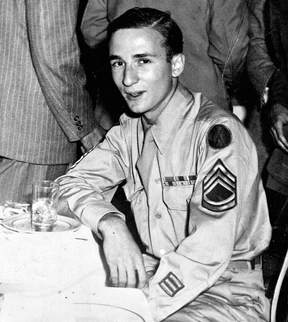
T/Sgt. Harry Paston - at dinner on
terminal leave - New York City - Sept. 1946
Click the image for a larger view
|
 More Images
More Images 

On maneuvers -
84th Airborne Division (Reserve) - summer training - division
signal company - not sure of location
Click
the image for a larger view
|
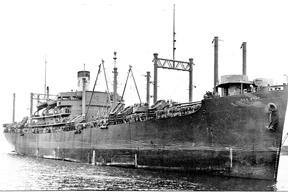
SS Sea Star - Sailed from Korea 8/17/46 bound for Seattle. Typhoon
enroute. Changed course for San Francisco, arriving under Golden
Gate Bridge September 1st.
Click the image for a larger view.
|

Sgt. Harry Paston
- On patrol on railroad tracks between Seoul and Chongju, Korea
Click the image for a larger view
|
|

Sgt.
Paston checking out a Korean skiff'
Click the image for a larger view.
|
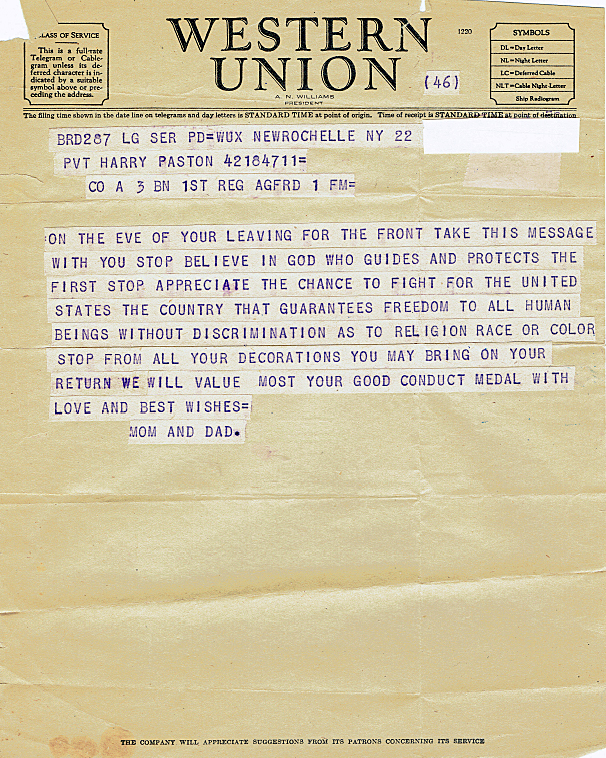
As PFC Harry Paston left for harm's way, a loving message from
his Mom and Dad. |
|

Send Corrections, additions,
and input to:
|